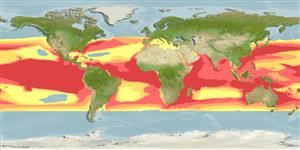Preferred temperature (Tài liệu tham khảo
123201): 17.9 - 28.9, mean 26.8 °C (based on 6810 cells).
Phylogenetic diversity index (Tài liệu tham khảo
82804): PD
50 = 0.5000 [Uniqueness, from 0.5 = low to 2.0 = high].
Bayesian length-weight: a=0.00562 (0.00451 - 0.00702), b=3.07 (3.03 - 3.11), in cm total length, based on LWR estimates for this species (Ref.
93245).
Mức dinh dưỡng (Tài liệu tham khảo
69278): 4.2 ±0.4 se; based on diet studies.
Thích nghi nhanh (Tài liệu tham khảo
120179): Rất thấp, thời gian nhân đôi của chủng quần tối thiểu là hơn 14 năm (K=0.1; tm=7; tmax=22; Fec=1).
Prior r = 0.06, 95% CL = 0.04 - 0.09, Based on 2 data-limited stock assessments.
Fishing Vulnerability (Ref.
59153): Very high vulnerability (84 of 100).
🛈
Climate Vulnerability (Ref.
125649): Very high vulnerability (76 of 100).
🛈
Nutrients (Ref.
124155): Calcium = 7.66 [1.45, 44.26] mg/100g; Iron = 0.723 [0.193, 2.260] mg/100g; Protein = 22.4 [19.6, 24.6] %; Omega3 = 0.259 [0.106, 0.652] g/100g; Selenium = 26 [8, 75] μg/100g; VitaminA = 6.58 [2.21, 19.27] μg/100g; Zinc = 0.355 [0.172, 0.669] mg/100g (wet weight);
